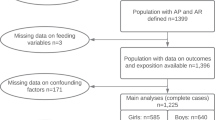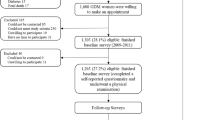Abstract
Background
There is growing evidence for a protective effect of breastfeeding against overweight and diabetes. It is less clear though, whether breastfed infants also have a more favorable cardiometabolic profile in childhood.
Objective
We investigated whether children who were breastfed in infancy had more favorable cardiometabolic markers at 12 years of age than children who were never breastfed and received formula milk instead, and whether associations depended on the duration of breastfeeding.
Methods
In 1509 participants of the population-based PIAMA birth cohort study, cardiometabolic markers were measured at 12 years of age. Duration of breastfeeding in weeks was assessed through parental questionnaires at 3 months and 1 year of age. Multivariable linear regression analysis was used to investigate associations of breastfeeding (any vs. never breastfeeding and duration of breastfeeding in categories <3 months, 3 to <6 months, and ≥6 months breastfeeding vs. never breastfeeding) with systolic and diastolic blood pressure (SBP and DBP, in Z-scores adjusted for age, sex, and height), total-to-high-density lipoprotein cholesterol (TC/HDLC), glycated hemoglobin (HbA1c, in mmol/mol), body mass index (BMI, in Z-scores adjusted for age and sex) and waist circumference (WC, in cm). Multivariable logistic regression was used to investigate the association of breastfeeding with odds of being overweight.
Results
1288 of 1509 children (85.3%) received any breastmilk in infancy. Breastfed children had a lower SBP Z-score (−0.21 SD (≈ −2.29 mmHg), 95% CI −0.37, −0.06), a lower DBP Z-score (−0.10 SD (≈ −1.19 mmHg), 95% CI −0.20, −0.00), a smaller WC (−1.12 cm, 95% CI −2.20; −0.04), and lower odds of being overweight (OR 0.61, 95% CI 0.38, 0.97) than never breastfed children. These associations were not different between children with shorter and longer duration of breastfeeding. No statistically significant differences in TC/HDLC, HbA1c, and BMI were observed between breastfed and never breastfed children.
Conclusions
We observed that breastfeeding was associated with a lower blood pressure, a smaller waist circumference and a lower risk of overweight in 12-year old children. These associations were independent of the duration of breastfeeding. No associations were observed between breastfeeding and other cardiometabolic markers.
This is a preview of subscription content, access via your institution
Access options
Subscribe to this journal
Receive 12 print issues and online access
$259.00 per year
only $21.58 per issue
Buy this article
- Purchase on Springer Link
- Instant access to full article PDF
Prices may be subject to local taxes which are calculated during checkout
Similar content being viewed by others
References
Organization WH Breastfeeding. 2017.
van Rossum C, Wijga A, Buijssen M, Jajou R, van Kessel F, Zeilmaker M, et al. Health effects of breastfeeding, a systematic literature review. Ann Nutr Metab. 2015;67:365–6.
Victora CG, Bahl R, Barros AJD, Franca GVA, Horton S, Krasevec J, et al. Breastfeeding in the 21st century: epidemiology, mechanisms, and lifelong effect. Lancet. 2016;387:475–90.
Yan J, Liu L, Zhu Y, Huang GW, Wang PP. The association between breastfeeding and childhood obesity: a meta-analysis. BMC Public Health. 2014;14:1267.
Penders J, Thijs C, Vink C, Stelma FF, Snijders B, Kummeling I, et al. Factors influencing the composition of the intestinal microbiota in early infancy. Pediatrics. 2006;118:511–21.
Backhed F, Roswall J, Peng YQ, Feng Q, Jia HJ, Kovatcheva-Datchary P, et al. Dynamics and stabilization of the human gut microbiome during the first year of life. Cell Host Microbe. 2015;17:852.
Komaroff AL. The microbiome and risk for atherosclerosis. JAMA. 2018;319:2381–2.
Horta BL, Loret de Mola C, Victora CG. Long-term consequences of breastfeeding on cholesterol, obesity, systolic blood pressure and type 2 diabetes: a systematic review and meta-analysis. Acta Paediatr. 2015;104:30–7.
Ravelli ACJ, van der Meulen JHP, Osmond C, Barker DJP, Bleker OP. Infant feeding and adult glucose tolerance, lipid profile, blood pressure, and obesity. Arch Dis Child. 2000;82:248–52.
Marmot MG, Page CM, Atkins E, Douglas JWB. Effect of breast-feeding on plasma-cholesterol and weight in young-adults. J Epidemiol Commun Health. 1980;34:164–7.
Kolacek S, Kapetanovic T, Zimolo A, Luzar V. Early determinants of cardiovascular risk-factors in adults—a plasma-lipids. Acta Paediatr. 1993;82:699–704.
Thorsdottir I, Gunnarsdottir I, Palsson GI. Association of birth weight and breast-feeding with coronary heart disease risk factors at the age of 6 years. Nutr Metab Cardiovas. 2003;13:267–72.
Owen CG, Martin RM, Whincup PH, Smith GD, Cook DG. Does breastfeeding influence risk of type 2 diabetes in later life? A quantitative analysis of published evidence. Am J Clin Nutr. 2006;84:1043–54.
Hui LL, Kwok MK, Nelson EAS, Lee SL, Leung GM, Schooling CM. The association of breastfeeding with insulin resistance at 17years: prospective observations from Hong Kong’s “Children of 1997” birth cohort. Matern Child Nutr. 2018;14:e12490.
Brunekreef B, Smit J, de Jongste J, Neijens H, Gerritsen J, Postma D, et al. The Prevention and Incidence of Asthma and Mite Allergy (PIAMA) birth cohort study: design and first results. Pedia Allerg Immunol. 2002;13:55–60.
Wijga AH, Kerkhof M, Gehring U, de Jongste JC, Postma DS, Aalberse RC, et al. Cohort profile: The Prevention and Incidence of Asthma and Mite Allergy (PIAMA) birth cohort. Int J Epidemiol. 2014;43:527–35.
Fredriks AM, van Buuren S, Burgmeijer RJ, Meulmeester JF, Beuker RJ, Brugman E, et al. Continuing positive secular growth change in The Netherlands 1955–1997. Pediatr Res. 2000;47:316–23.
Fredriks AM, van Buuren S, Fekkes M, Verloove-Vanhorick SP, Wit JM. Are age references for waist circumference, hip circumference and waist-hip ratio in Dutch children useful in clinical practice? Eur J Pediatr. 2005;164:216–22.
Talma H, Schonbeck Y, Bakker B, HiraSing RA, van Buuren S. Groeidiagrammen 2010. Koninklijke de Swart: Den Haag.
Cole TJ, Lobstein T. Extended international (IOTF) body mass index cut-offs for thinness, overweight and obesity. Pediatr Obes. 2012;7:284–94.
Pickering TG, Hall JE, Appel LJ, Falkner BE, Graves J, Hill MN, et al. Recommendations for blood pressure measurement in humans and experimental animals: part 1: blood pressure measurement in humans: a statement for professionals from the Subcommittee of Professional and Public Education of the American Heart Association Council on High Blood Pressure Research. Circulation. 2005;111:697–716.
Prog NHBPE. The fourth report on the diagnosis, evaluation, and treatment of high blood pressure in children and adolescents. Pediatrics. 2004;114:555–76.
Grp DR. The Diabetes Control and Complications Trial (Dcct)—design and methodologic considerations for the feasibility phase. Diabetes. 1986;35:530–45.
Owen CG, Martin RM, Whincup PH, Smith GD, Cook DG. Effect of infant feeding on the risk of obesity across the life course: a quantitative review of published evidence. Pediatrics. 2005;115:1367–77.
Arenz S, Ruckerl R, Koletzko B, von Kries R. Breast-feeding and childhood obesity—a systematic review. Int J Obes Relat Metab Disord. 2004;28:1247–56.
Martin RM, Patel R, Kramer MS, Guthrie L, Vilchuck K, Bogdanovich N, et al. Effects of promoting longer-term and exclusive breastfeeding on adiposity and insulin-like growth factor-I at age 11.5 years a randomized trial. JAMA. 2013;309:1005–13.
Harder T, Bergmann R, Kallischnigg G, Plagemann A. Duration of breastfeeding and risk of overweight: a meta-analysis. Am J Epidemiol. 2005;162:397–403.
Gillman MW. Commentary: breastfeeding and obesity—the 2011 Scorecard. Int J Epidemiol. 2011;40:681–4.
Owen CG, Martin RM, Whincup PH, Davey-Smith G, Gillman MW, Cook DG. The effect of breastfeeding on mean body mass index throughout life: a quantitative review of published and unpublished observational evidence. Am J Clin Nutr. 2005;82:1298–307.
Kramer MS, Moodie EE, Dahhou M, Platt RW. Breastfeeding and infant size: evidence of reverse causality. Am J Epidemiol. 2011;173:978–83.
Brion MJ, Lawlor DA, Matijasevich A, Horta B, Anselmi L, Araujo CL, et al. What are the causal effects of breastfeeding on IQ, obesity and blood pressure? Evidence from comparing high-income with middle-income cohorts. Int J Epidemiol. 2011;40:670–80.
Martin RM, Patel R, Kramer MS, Vilchuck K, Bogdanovich N, Sergeichick N, et al. Effects of promoting longer-term and exclusive breastfeeding on cardiometabolic risk factors at age 11.5 years a cluster-randomized, controlled trial. Circulation. 2014;129:321–9.
Owen CG, Whincup PH, Gilg JA, Cook DG. Effect of breast feeding in infancy on blood pressure in later life: systematic review and meta-analysis. BMJ. 2003;327:1189–95.
Chen XL, Wang YF. Tracking of blood pressure from childhood to adulthood—a systematic review and meta-regression analysis. Circulation. 2008;117:3171–80.
Singh AS, Mulder C, Twisk JWR, van Mechelen W, Chinapaw MJM. Tracking of childhood overweight into adulthood: a systematic review of the literature. Obes Rev. 2008;9:474–88.
Hubert HB, Feinleib M, Mcnamara PM, Castelli WP. Obesity as an independent risk factor for cardiovascular-disease—a 26-year follow-up of participants in the Framingham Heart-Study. Circulation. 1983;67:968–77.
Chobanian AV, Bakris GL, Black HR, Cushman WC, Green LA, Izzo JL, et al. The Seventh Report of the Joint National Committee on prevention, detection, evaluation, and treatment of high blood pressure—The JNC 7 Report. JAMA. 2003;289:2560–72.
Author information
Authors and Affiliations
Corresponding author
Ethics declarations
Conflict of interest
The authors declare that they have no conflict of interest.
Additional information
Publisher’s note: Springer Nature remains neutral with regard to jurisdictional claims in published maps and institutional affiliations.
Rights and permissions
About this article
Cite this article
Pluymen, L.P.M., Wijga, A.H., Gehring, U. et al. Breastfeeding and cardiometabolic markers at age 12: a population-based birth cohort study. Int J Obes 43, 1568–1577 (2019). https://doi.org/10.1038/s41366-018-0317-5
Received:
Revised:
Accepted:
Published:
Issue Date:
DOI: https://doi.org/10.1038/s41366-018-0317-5
This article is cited by
-
Breastfeeding is associated with reduced risks of central obesity and hypertension in young school-aged children: a large, population-based study
International Breastfeeding Journal (2023)
-
Association of breastfeeding duration, birth weight, and current weight status with the risk of elevated blood pressure in preschoolers
European Journal of Clinical Nutrition (2020)



